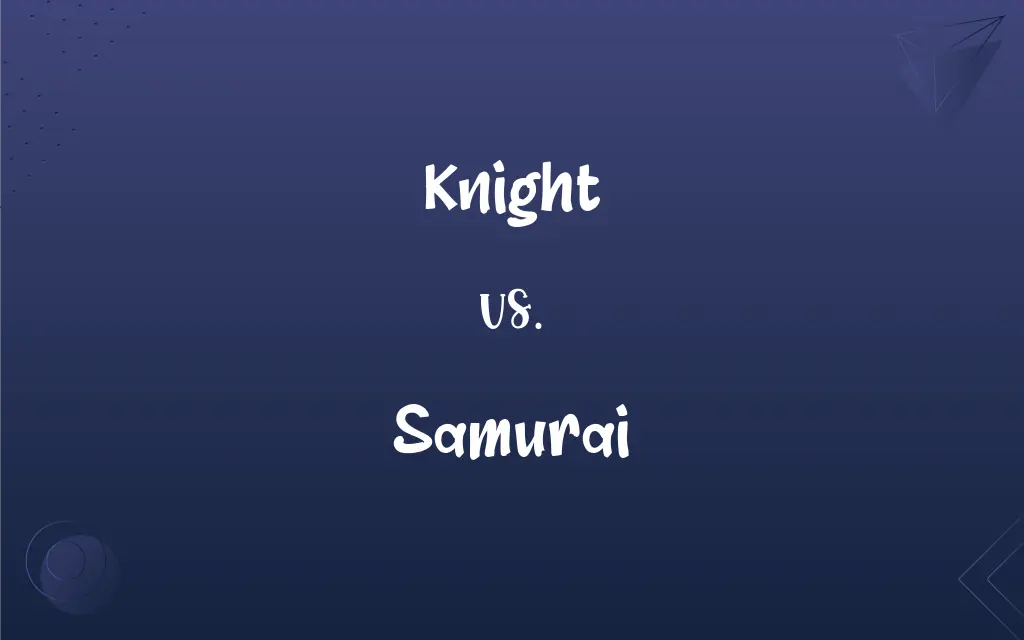Knight vs. Samurai: What's the Difference?
Edited by Janet White || By Harlon Moss || Updated on October 6, 2023
A knight is a European medieval warrior of noble status, while a samurai is a Japanese warrior class serving feudal lords.

Key Differences
Both knights and samurai were iconic figures in their respective societies, recognized as warriors who upheld codes of honor and ethics. Knights hailed from medieval Europe and were tied to the system of feudalism. Typically, a knight served a liege lord and was often granted land or other privileges in return for military service. In contrast, samurai were the warrior class in feudal Japan and pledged loyalty to their daimyō, or local lords, valuing honor and martial skill above all.
Knighthood and samurai-ship were both bound by strict codes of conduct. Knights followed the chivalric code, which emphasized values like bravery, courtesy, and honor, especially in battle. On the other hand, samurai followed the Bushidō code, which also stressed bravery, loyalty, and honor but placed a particular emphasis on the willingness to commit ritual suicide, or seppuku, in the face of disgrace.
In terms of armor and weaponry, knights and samurai were distinctively equipped. Knights wore metal armor, including chainmail and later plate armor, and their primary weapons were swords, lances, and maces. Samurai, in contrast, wore armor made from leather and metal lamellae and wielded the katana, a razor-sharp sword, as their main weapon, alongside bows and spears.
Culturally, knights and samurai held immense influence in their societies. The imagery of the knight is heavily associated with medieval European tales and legends, often playing roles in stories about quests and chivalric romance. Samurai, meanwhile, are central to Japanese history, culture, and art, depicted in numerous tales, dramas, and artworks emphasizing their dedication to honor and their martial prowess.
Comparison Chart
Origin
Medieval Europe
Feudal Japan
ADVERTISEMENT
Code of Honor
Chivalric code
Bushidō code
Armor Type
Chainmail and plate armor
Leather and metal lamellae armor
Primary Weapon
Swords, lances, maces
Katana, bows, and spears
Cultural Influence
European tales and chivalric romance
Japanese history, dramas, and art
Knight and Samurai Definitions
Knight
A central figure in European tales and legends.
The knight embarked on a quest to find the Holy Grail.
ADVERTISEMENT
Samurai
A figure bound by the Bushidō code of honor.
Honor was paramount to the samurai's way of life.
Knight
A medieval European warrior of noble lineage.
The knight swore fealty to his king.
Samurai
A skilled martial artist, adept with the katana.
In battle, the samurai's prowess was unmatched.
Knight
A figure bound by the chivalric code of honor.
The knight upheld his vow to defend the realm.
Samurai
A cultural symbol of Japan's history and values.
Stories of samurai valor are passed down through generations.
Knight
A person bestowed with a title of honor by a monarch.
For his services, he was named a knight by the queen.
Samurai
A warrior prepared for seppuku in the face of disgrace.
To restore his honor, the samurai chose seppuku.
Knight
A warrior granted land in return for military service.
The knight's estate was vast, a reward for his valor.
Samurai
A member of the warrior class in feudal Japan.
The samurai was loyal to his daimyō.
Knight
A medieval tenant giving military service as a mounted man-at-arms to a feudal landholder.
Samurai
The Japanese feudal military aristocracy.
Knight
A medieval gentleman-soldier, usually high-born, raised by a sovereign to privileged military status after training as a page and squire.
Samurai
A professional warrior belonging to this class.
Knight
A man holding a nonhereditary title conferred by a sovereign in recognition of personal merit or service to the country.
Samurai
In feudal Japan, a soldier who served a daimyo.
FAQs
Were both knights and samurai warriors?
Yes, both were esteemed warriors in their societies.
Where did knights originate from?
Knights hailed from medieval Europe.
What is the iconic sword of a samurai?
The iconic sword of a samurai is the katana.
Were there female samurai?
Yes, some women, known as onna-bugeisha, were trained in martial arts and fought alongside samurai.
Did knights and samurai ever encounter each other?
Historically, knights and samurai had no direct encounters due to geographical and temporal separations.
Were knights' shields important?
Yes, shields were crucial for knights' defense in battle.
Were knights associated with a particular class?
Knights typically belonged to the noble class.
Was seppuku a practice among samurai?
Yes, samurai might commit seppuku, or ritual suicide, in the face of disgrace.
Did samurai participate in duels?
Yes, samurai might engage in duels to settle disputes or demonstrate skill.
What was the primary code for samurai?
Samurai followed the Bushidō code.
Were samurai skilled in archery?
Yes, besides their katana, many samurai were adept archers.
What were knights' primary duties?
Knights were obligated to provide military service, protect their liege, and uphold the chivalric code.
Were there female knights?
Historically, knighthood was male-dominated, but there were rare cases of female knights.
Did samurai serve a specific lord?
Yes, samurai served and were loyal to their daimyō.
What type of armor did knights wear?
Knights wore metal armor, including chainmail and plate armor.
Was chivalry important for knights?
Yes, knights were bound by the chivalric code of honor.
Are there tales and stories about samurai?
Yes, samurai are central to numerous Japanese tales and artworks.
Could anyone become a knight?
Typically, knighthood was reserved for those of noble lineage or through significant deeds.
Did knights engage in jousting?
Yes, jousting was a popular sport among knights.
Did samurai have a specific way of life?
Yes, samurai led a disciplined life, emphasizing honor, martial training, and loyalty.
About Author
Written by
Harlon MossHarlon is a seasoned quality moderator and accomplished content writer for Difference Wiki. An alumnus of the prestigious University of California, he earned his degree in Computer Science. Leveraging his academic background, Harlon brings a meticulous and informed perspective to his work, ensuring content accuracy and excellence.
Edited by
Janet WhiteJanet White has been an esteemed writer and blogger for Difference Wiki. Holding a Master's degree in Science and Medical Journalism from the prestigious Boston University, she has consistently demonstrated her expertise and passion for her field. When she's not immersed in her work, Janet relishes her time exercising, delving into a good book, and cherishing moments with friends and family.







































































